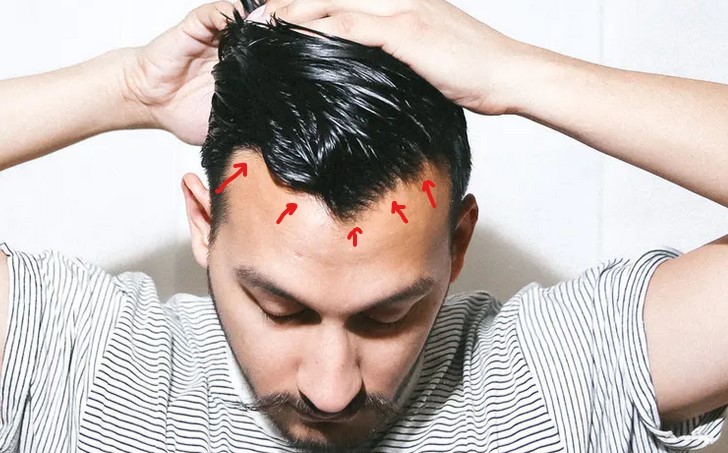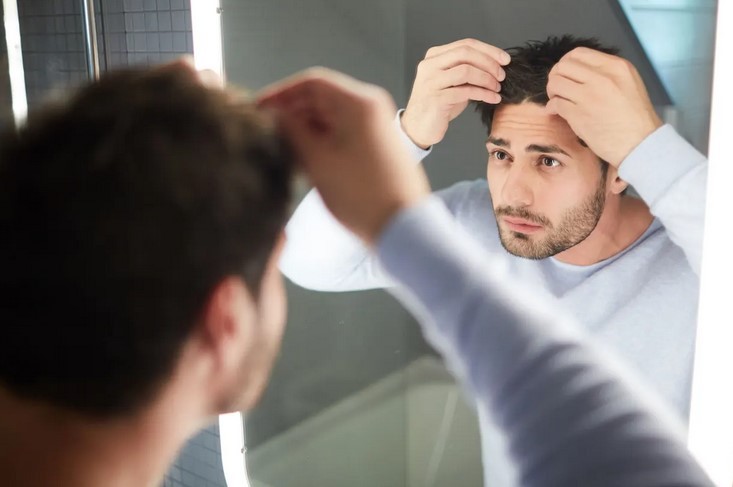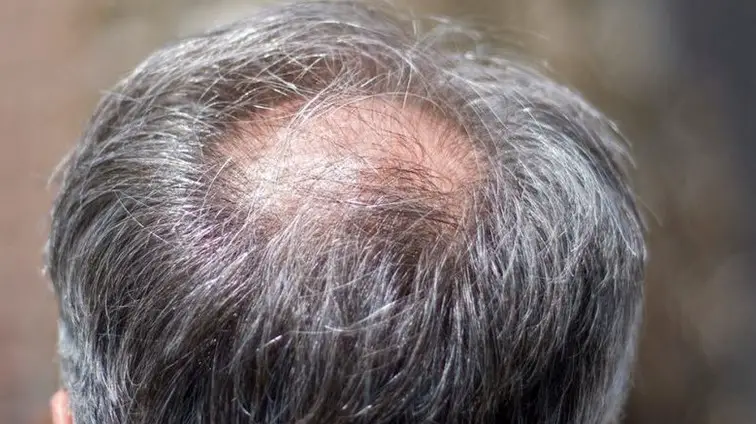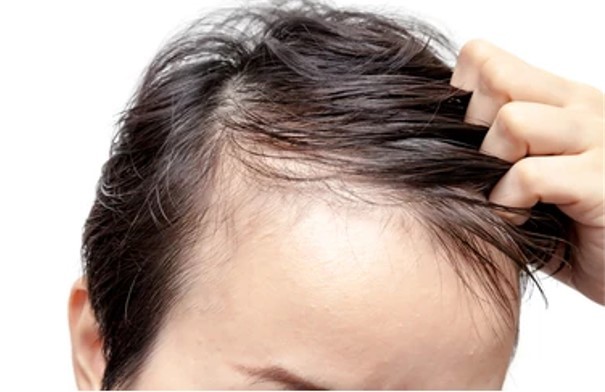Spotting high hairline or balding at the crown, but wondering, “is mature hairline balding”, and what’s the difference between the mature hairline and receding hairline? It’s a good thing you ask because if you think your hairline is starting to recede, and you’re unsure how to tell if mature hairline or balding, we’ll help tell the difference.
It is difficult to distinguish between just a maturing of your hairline and male pattern baldness during the early stages of balding.
Seeing those three words together mature hairline and receding make any man cringe because it conjures up thoughts of receding hairlines, thinning hair, or worst of all – going bald. So is mature hairline balding?
No, balding happens when hair is lost or a form of a bald spot after the hairline starts to recede. It usually occurs because of male pattern baldness.
One in every five UK guys in their early age will experience signs of balding at 20. One out of every three males aged 30 will also go bald young. By the time they reach their forties, nearly half of England’s males will become bald.
But before you go reaching for the panic button, let’s take a step back and look at what could possibly be causing your hairline to change.
You will also like:
Mature hairline at 20
If you’re in a young age and are experiencing a maturing hairline at 20 it is just an early sign of balding and part of ageing, and it’s totally normal to see hair loss or thinning, it may be hard to tell if it’s part of the process of getting older or if you have male pattern baldness. Fortunately, there are ways to tell the difference, as described below.
Mature hairline
A maturing hairline may show signs of male pattern baldness when it starts to gradually recede until it reaches its last stopping point.
There are different types of hairlines, for one widow’s peak which is where the hairline takes a more defined M-shaped line as a result of the hairline receding further on the sides leaving a larger area of hair more centrally on the forehead. It is debated whether this is just because of age, or if it’s an early sign of Male Pattern Baldness (MPB). One way to tell if you’re starting to go bald is if your hairline starts moving back and then up – about 1.5 cm – 2 cm from the brow line, and your temples become noticeably thinner.
Our hair defines who we are, so it’s only normal that some people experience changes in the frontal hairline shape of the head as they grow older. Men will start noticing a maturing hairline around the age of 17, while females will experience it at an earlier stage – between 10-12 years old. This transition is nothing to worry about because it is just one step in the natural hair cycle.
Balding
Balding can be due to the amount of hair is lost from the head, and can be in terms of Norwooding common for people who suffer from Androgenetic Alopecia (Male or Female Pattern Hair Loss). Which can cause bald patches on the scalp. The Anagen Phase of Hair – Where Yours Is!
Maturing hairline vs receding hairline
By definition, a maturing hairline is a receding hairline – but the difference lies in where the recession stops as well as a few other factors.
You have an extra recession at the temples
Beyond just a subtle V-shape that can form with a maturing hairline, men who experience receding hairlines will see additional recession at their temples, forming more of an M-shape. It means they’re now in stage III on the Norwood Scale – which is when you start losing your hair.
Receding hairlines are often more noticeable than their mature counterparts because they occur faster
A person might notice the transformation from a juvenile line to a receding one once their hairline goes higher than two inches from the top of their forehead.
The person might also experience thinning or excessive shedding that’s abnormal for them before they see signs of hair loss near the temple area and crown of the head.
Keep in mind that there are plenty of reasons why someone would experience these symptoms other than just losing hair; it could be something as simple as stress-related balding or another chronic illness – so talk to your doctor for diagnosis and treatment options if you’re worried about something specific.
You have a lot of small, fine hairs beyond your hairline.
Having too many small, fine hairs in front of your hairline can also mean there is an underlying problem. Hair loss isn’t always about loss of the large terminal follicle (the one at the back), it can also be attributed to miniaturization of the hair follicles – which will lead to receding temples and eventually baldness.
Mature hairline characteristics
Hairlines mature in men come to maturity at different times and different paces. And just like weight gain, the change can be so gradual that most men don’t even notice it happening. Certain features differentiate a matured hairline from male pattern baldness:
- The mature hairline moves back fairly evenly, which is why the change can go unnoticed for a long time.
- The mature hairline usually moves up no higher than an inch above the highest wrinkle on your forehead.
- The matured hairline remains defined, even if its shape changes over time- sometimes appearing more V-shaped in certain cases where temple hairs start to recede and show less fullness along the sides of his head.
- A maturing line is where a person’s have a V-shaped hairline naturally recedes as they get older.
Maturing Hairline vs Balding
Maturing hairline and balding are two terms that often get mixed up. There’s a common belief that you can’t tell if you’re going bald unless your hair starts to recede. This is false. In fact, what most people refer to as balding is usually more accurately described as maturing hairline. People who are going bald will experience thinning on top of their head – not a thinning of their entire scalp. If someone has a maturing hairline, they will likely experience thinning or slow growth at their temples, while there may be thickening or fast-growing hair elsewhere on their head (such as above and behind their ears).
Mature vs receding hairline
Both receding and maturing hairline conditions can leave you feeling insecure. While both do involve a loss of hair on your head, they are completely different conditions. Maturing and receding hairlines differ in several ways, including how they develop and how men should treat them differently. Understanding these differences is important to help you make informed decisions about your treatment options. Read on to learn more about maturing vs receding hairlines in men.
How to tell if your hairline is receding or maturing
Use your index finger to see how long of a distance there is between your temple and forehead. If it’s less than an inch, chances are you aren’t balding. In fact, many men experience what is known as maturing hairline or early-onset receding hairline. When it comes to maturing hairlines and balding hairlines, it’s pretty much impossible to tell who’s going bald before they actually go bald. A better indication of whether or not you’re experiencing an early-onset receding hairline would be if you had a big forehead during your teen years.
The first sign of maturing hairline is that your frontal hairline started to move back. As you get older, your hair will grow back at different rates on each side, which causes your part to shift from being perfectly centred over your head. In addition, as you age, it’s normal for one or both of your temples to start receding — a.k.a., getting thinner and flatter. Although most people don’t realize it, hair loss does occur in younger people — but not usually until their late teens or early 20s. When men are younger than 25 years old and beginning to lose their hair, they have a condition called pattern baldness.
What does a mature hairline look like

If you’re in your 20s or 30s, you may wonder what a mature hairline looks like. It depends on many factors, including your genetic makeup, age and lifestyle. While balding may become more apparent in middle age and beyond, not everyone with a maturing hairline is going to experience significant thinning of their crown over time.
It’s normal for hair to recede on both sides of your head, and your hairline should continue to mature throughout your 20s and 30s. To determine if you have a healthy, mature hairline, use an eyebrow pencil or eye-shadow stick to mark where your eyebrows are. Take a picture of it with a camera, so you can see what it looks like from every angle. This will give you an idea of what a healthy mature hairline looks like at different angles.
Juvenile hairline vs mature hairline
There are two types of hair loss, juvenile and mature. While juvenile hair loss is characterized by patterns like cowlicks and U-shaped hairlines, mature hair loss is characterized by an overall thinning of hair from your head.
Does m shaped hairline mean balding
M-shaped hairlines mean that you have a combination of maturing hairline and receding hairline, where your hair is thinning but only in some spots. This is also called male pattern baldness but contrary to popular belief, it’s not just for men! Women can have it too, but they show a different pattern on their head than men do. Both men and women experience M-shaped hairlines because they age or mature. For both genders, we lose about 50% of our scalp hairs by age 60 (and most people are completely bald by age 80). In men, patterns start changing in their 20s; for women (who don’t go bald), their hairlines grow back differently later in life.
How to reverse maturing hairline
As you get older, your hair will likely experience many changes. Some of these changes are unavoidable, such as hair loss caused by male pattern baldness or aging in general. However, there are several ways to slow down or stop maturing hairline from occurring. With a few lifestyle changes and helpful products, anyone can stop their receding hairlines from getting worse and even reverse maturing hairline if they catch it in time. The first step is to understand what causes premature receding of your hairline and how to prevent it before it happens.
Conclusion
If you’re doubting whether or not your hairline is showing signs of a mature or receding hairline, check these points out.
A maturing hairline isn’t always a sign of balding.
Male pattern baldness shows signs such as thinning crowns, receding hairlines, and even early-stage Norwood stages (1-3).
Male pattern baldness is often genetic in nature and hereditary – it also involves shrinking hair follicles.
Maturing hairlines usually start before balding, though sometimes they can happen later on too.
- AI Powered Bald Filter Online 2024: See Yourself with No Hair! - January 19, 2024
- Harklinikken Bad Reviews 2024: Analyzing Negative Feedbacks - January 18, 2024
- How to Get the Alex Eubank Hair | Step-By-Step Tutorial 2024 - January 18, 2024







